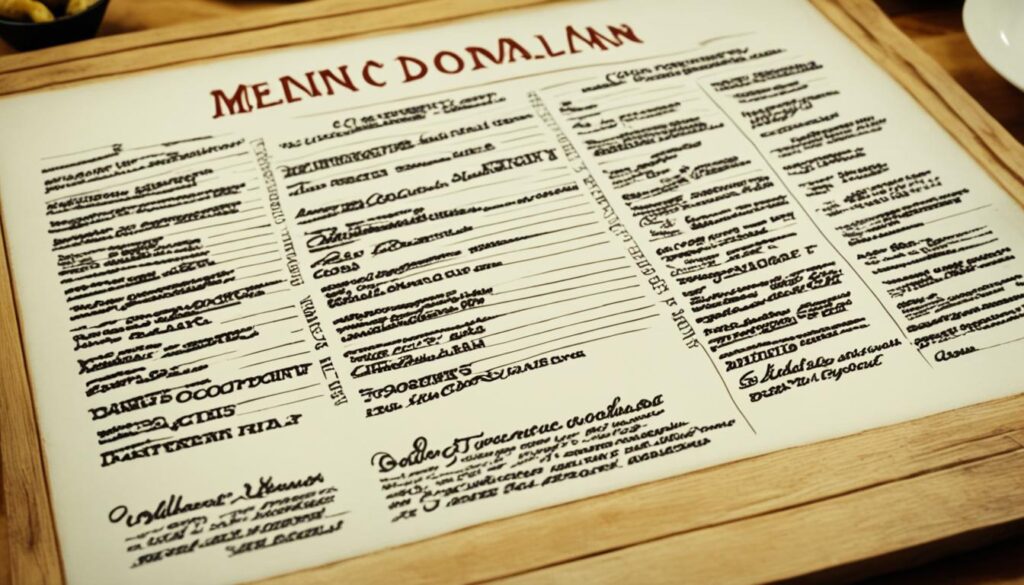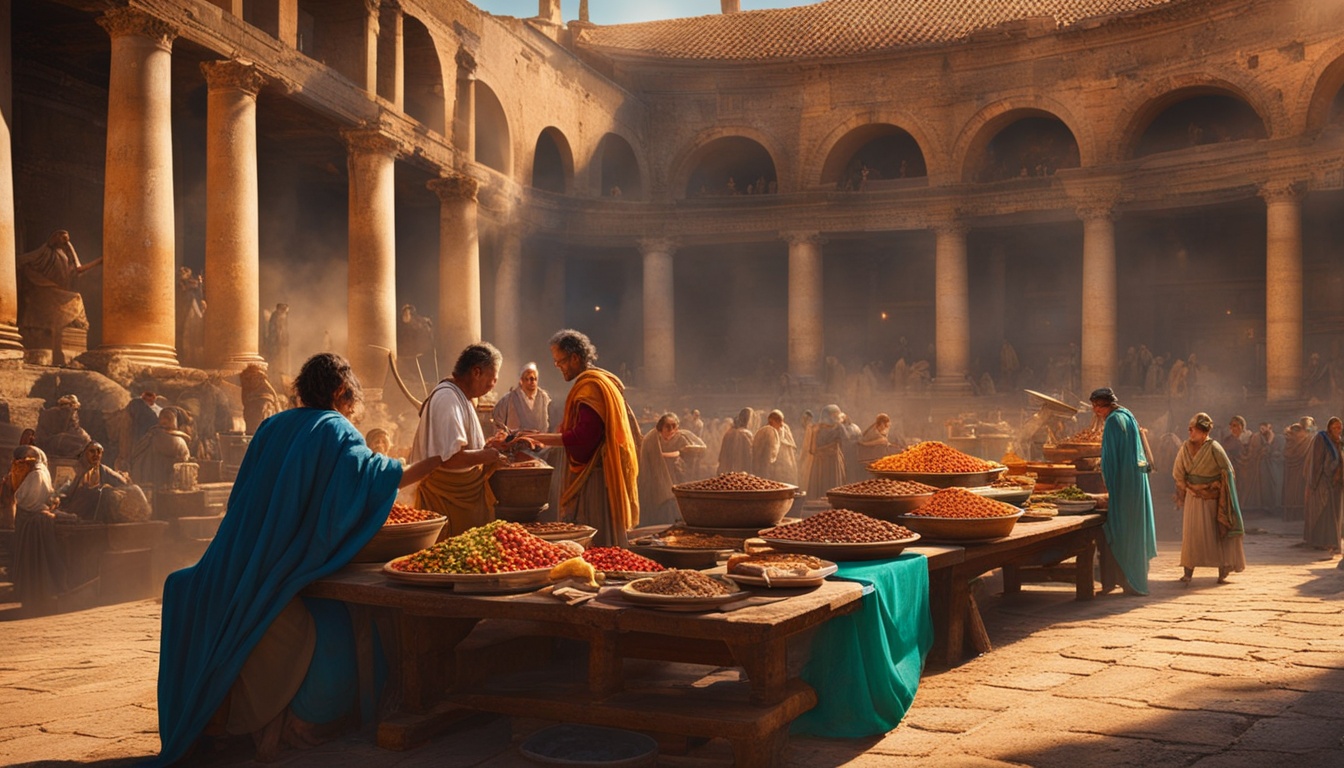In the bustling streets of ancient Roman towns like Pompeii, Herculaneum, and Ostia, one could find the equivalent of modern fast-food restaurants on nearly every corner. These eateries, known as thermopolia, were easily recognizable by their distinctive masonry counters embedded with earthenware jars called dolia, which stored dried foods and drinks. The name thermopolium derives from the Greek words meaning “a place where something hot is sold.”
In Latin literature, these ancient Roman fast-food establishments were also referred to by various terms such as popinae (a general term for restaurant), tabernae (taverns or snack bars), cauponae (establishments that served food and drink), hospitia (hotels with dining facilities), and stabula (alternative names for taverns or pubs). These eateries played a significant role in Roman society, reflecting the dietary habits and social dynamics of the time.
Key Takeaways
- Thermopolia were the ancient Roman equivalent of modern fast-food restaurants
- These eateries were found on nearly every street corner in Roman towns like Pompeii and Herculaneum
- Thermopolia had distinctive masonry counters with embedded earthenware jars called dolia for storing food and drinks
- Various Latin terms were used to refer to these fast-food establishments, including popinae, tabernae, and cauponae
- Ancient Roman fast-food eateries reflect the dietary habits and social dynamics of Roman society
Thermopolia: The Fast-Food Restaurants of Ancient Rome
In ancient Rome, thermopolia were the equivalent of modern-day fast-food restaurants. The thermopolium design was optimized for quick service and convenience, making them popular among the city’s bustling populace. These establishments featured large counters facing the street, with a receptacle in the middle called a dolia, from which food and drink were served.
While some upscale thermopolia had decorated back rooms that may have served as dining areas, most focused on providing ancient Roman fast food for takeaway. This was particularly important for the many Romans living in multi-story apartment blocks known as insulae, which often lacked private kitchens. As a result, these city dwellers relied heavily on thermopolia for their daily meals.
Archaeologists have discovered evidence suggesting that residents of insulae frequently used small, portable braziers for cooking within their homes. This practice likely emerged as a way to avoid the risk of fires in the densely packed urban areas, where open flames could quickly spread and cause significant damage.
The thermopolium design, with its emphasis on fast service and takeaway options, was well-suited to the needs of ancient Rome’s urban population. By providing quick and convenient access to food, these establishments played a crucial role in the daily lives of many Romans, particularly those living in the city’s insulae without access to private cooking facilities.
Menu and Culinary Offerings at Thermopolia
The ancient Roman fast food menu at thermopolia was designed to cater to the diverse tastes and needs of the Roman populace. These establishments offered a variety of quick, convenient, and affordable dishes that could be easily consumed on the go. One of the staple items on the menu was lentils, a nutritious and filling legume that was widely cultivated in the Roman Empire.
Meat, another essential component of the Roman diet, was also readily available at thermopolia. Patrons could enjoy various meat dishes, such as grilled or roasted pork, beef, and chicken. These proteins were often seasoned with herbs and spices to enhance their flavor. Additionally, cheese was a popular choice among Romans, and thermopolia offered a range of cheese-based snacks and dishes.

One of the most iconic beverages served at thermopolia was calida, a type of warmed spice wine. This comforting drink was particularly popular during colder months and was believed to have medicinal properties. Another ubiquitous condiment in ancient Roman cuisine was garum, a fermented fish sauce that added a rich, umami flavor to various dishes.
Thermopolia also catered to those with a sweet tooth by offering indulgent treats like baked cheese drizzled with honey. This combination of savory and sweet flavors was highly favored by the Romans. Nuts, such as almonds and walnuts, were another common snack that could be purchased at these establishments, providing a quick and healthy energy boost for patrons on the move.
Ancient Roman Fast-Food: A Reflection of Roman Society
The prevalence of thermopolia in ancient Roman cities serves as a testament to the diverse dining habits and social structure of the time. For the urban poor and working-class Romans residing in crowded insulae, cooking at home was often an impractical and cumbersome task. As a result, fast-food establishments like thermopolia became a necessity, providing convenient and affordable meals to the masses.
On the other hand, wealthy Romans had the luxury of living in homes equipped with dedicated dining rooms, known as triclinia. They also had the privilege of having slaves to prepare elaborate meals, showcasing their affluence and social status. Despite this, some well-to-do individuals occasionally patronized thermopolia, although they generally viewed these eateries with a sense of disdain, considering them beneath their social standing.
The popularity of thermopolia among the lower echelons of Roman society highlights the substantial demand for quick and inexpensive dining options in the bustling cities of ancient Rome. These establishments catered to the needs of the working class, who often lacked the time, resources, or facilities to prepare their own meals. Thermopolia became an integral part of the urban landscape, reflecting the daily lives and struggles of the common people.
The contrast between the dining habits of the wealthy and the poor in ancient Rome underscores the stark social divisions that existed within Roman society. While the elite enjoyed the luxury of private dining experiences, the masses relied on the convenience and affordability of fast-food establishments like thermopolia. This dichotomy serves as a reminder of the complex social fabric that characterized ancient Roman civilization.
Controversy and Attempts to Regulate Thermopolia
While thermopolia served as popular gathering spots for ancient Romans, they also attracted controversy due to the gambling and drinking that often took place within their walls. These activities led some Roman emperors to view the establishments as potential threats to public order. The historian Dio recounted an incident in which Emperor Caligula allegedly sentenced a man to death for the crime of selling hot water, a move that would have directly impacted the operations of thermopolia.
Later, during the reign of Emperor Claudius, efforts were made to regulate and even shut down these ancient fast-food restaurants. Claudius reportedly ordered the closure of thermopolia and imposed punishments on those who disobeyed his command. These actions underscore the concern that Roman rulers had regarding the potential for unruly behavior and social unrest stemming from the gatherings at these eateries.
Despite the attempts by various Roman emperors to curtail the activities within thermopolia, the establishments remained a staple of Roman society. The convenience and affordability of the food and drink they offered, coupled with their function as social hubs, ensured their continued popularity among the urban population. While the controversies surrounding gambling and drinking persisted, thermopolia continued to serve as a vital source of quick, hot meals for the masses in ancient Rome.

Leave a Reply